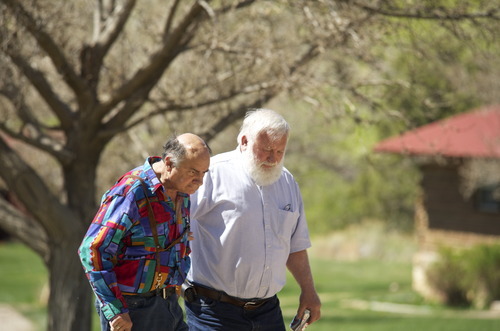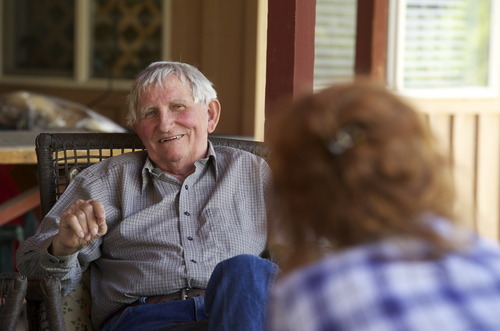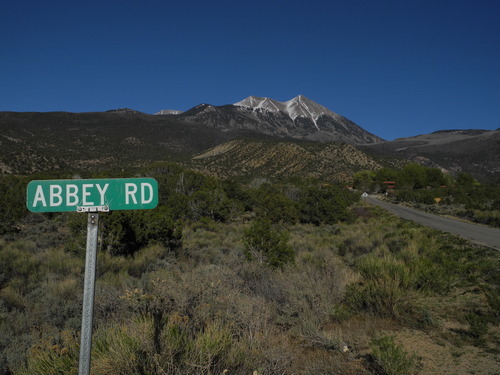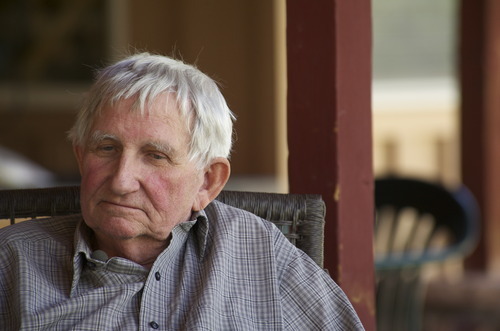This is an archived article that was published on sltrib.com in 2012, and information in the article may be outdated. It is provided only for personal research purposes and may not be reprinted.
Moab • It's after midnight at Pack Creek Ranch, a cache of cabins tucked into the cottonwoods and pines of the foothills below 12,000-foot Mount Peale, still snow-capped on a late spring day.
Stories of bygone river-running days flow between old friends and river guides inside Ken and Jane Sleight's cabin here.
SPLORE founder and retired river guide Martha Ham orchestrated the gathering to record the group's stories. She has a soft spot for one man in particular here.
When no other outfitter back in the late '70s would help Ham with SPLORE, a nonprofit group that still takes people of all abilities, including the disabled, on river trips, Sleight helped Ham get started.
At a long table beneath a chandelier, Ham sits next to Sleight with her recorder, its red light glowing as he relives river-related memories.
Ham hopes people researching Utah river history someday will benefit from her recordings, which she is donating to the University of Utah's Marriott Library.
"We can't afford to [make the recordings], and having people like Martha do things like that is just fabulous for us," said U. multimedia archivist Roy Webb, himself a former river guide. "She has a sense that this is important history and we share that feeling."
John and Susette Weishert also show up at Pack Creek the same April weekend.
They're part of Sageland Media, which is making a documentary about Sleight, 82, a legend among pioneering river guides for his exploits back in the 1950s, '60s and '70s.
Back then, Sleight was pals with Edward Abbey, who shoveled some Sleight DNA into the character Seldom Seen in the seminal eco-activist novel The Monkey Wrench Gang. Abbey sometimes wrote while at Pack Creek Ranch.
Ham also courted retired river guides Art Fenstermaker and Art Gallenson to Pack Creek Ranch. They're Sleight disciples who were teenagers when they met their mentor at Salt Lake City's East High School.
Fenstemaker, now with a bushy white beard; Gallenson, who has been slowed by Parkinson's; and hard-of-hearing Sleight for three days filled the air here with memories of what the Colorado River was like before the Glen Canyon Dam.
They remember showing a generation of Boy Scouts terrain that will never be the same.
And they recall the old days when there were tougher customers who wanted a raw wilderness experience and didn't expect to be pampered.
River running teaches you to fend for yourself and to care for others, they say — to take charge and not expect that someone will get you out of a jam.
That was Sleight's way on the river. He was never sued and no one died on his watch, even when it seemed like raging rapids might swallow a customer or two.
From office to river • As a young man, Sleight caught the river-running bug from Malcom "Moki Mac" Ellingson.
He never lost it, even when the Korean War interrupted his schooling at the U. of U.
Sleight completed a business degree in 1955 after returning from Korea. He put on a bow tie and went to work for Firestone. That same year he bought his first boat.
It didn't take long before Sleight decided to chuck one career path for the one his gut told him he should take.
At $35 each for five 10-man rafts, "I was in business," Sleight said.
He ran the Green and Colorado rivers and their tributaries down Glen, Desolation, Cataract and Grand canyons. At first he took Boy Scouts on trips.
After a few years he was in debt and at a crossroads: Get out or dive in deeper.
Sleight advertised and started taking more adults on extended trips, tripling his prices and, he says, acting more like an outfitter.
"The river was such an attraction," Sleight tells Ham.
Sleight realized just how much the river, even just one trip, could change lives.
"It did mine," he says, adding caveats.
It could ruin marriages. It could reshape faith in God.
And it could influence young men, such as Fenstermaker and Gallenson to become river guides after a few trips.
Sleight relishes talking about how the young men were protesting the quality of cafeteria food at East High when they first met.
"They were in cahoots," smiles Sleight, who was substitute teaching at the time. He liked that the boys were "rising up" against an injustice, even if it was only about bad hamburgers. "I thought that was great."
He took the boys on a river trip, and soon after they were working for him, at first for free or as little as $25 a week.
An activist lives on • The boys became men and river guides and eventually shed their agitating ways.
Sleight?
He's still an activist.
These days, however, he's probably not going to reprise the time more than 20 years ago when he stood down a bulldozer while on horseback.
Sleight recalls how drivers were pulling a giant anchor chain between their bulldozers in an area known as Amasa Back as they ripped out trees to clear the way for better livestock grazing conditions. He didn't think the chaining order was necessary, and he was worried the Bureau of Land Management was not being careful enough around possible Indian artifacts.
Sleight rode his bay horse Knothead from Pack Creek Ranch up to the tractors and didn't move until law enforcement ended the standoff as other protesters looked on.
Ask him about Glen Canyon Dam, and he still wishes it — and Lake Powell — would go away, but not by means of the kind of monkey-wrenching Abbey's Seldom Seen might have advocated.
"If Glen Canyon was still there, then I'd be there," Sleight says.
Sleight wistfully talks about how Abbey hasn't come through yet with a "precision" earthquake to take down the dam. No divine monkey wrenching.
"I thought he had more influence," Sleight says.
Maybe a drought will do in the dam. Or political action might take it down. Maybe it's there for good.
For decades he's called it "Lake Foul," and he'd love to see it gone, forever.
The stories flow • Sleight's memory of things that happened 40 and 50 years ago have come alive for one weekend.
You can see how grateful he is for time with Fenstermaker and Gallenson.
At one point Fenstermaker tells Ham about a time when Sleight bought a spare battery before a river trip and transported it on the passenger seat of his truck.
The battery tipped over, spilled acid on the seat and necessitated putting plastic over the mess so a "good-sized" schoolteacher could safely sit there for a ride to the launch site.
Problem was she had worked the plastic out from over the acid spill, which by the time they reached the riverbank had eaten away at her clothes.
"That was one of the larger moons I'd seen," recalls Fenstermaker, who was still an apprentice at the time.
Laughter.
The unfortunate woman's rear was "kind of red," but she was apparently not burned "too bad" and still went on the trip, Fenstermaker says.
More laughter.
"Amazing," Sleight pipes in. "You hit it right, clear — you got a good mind."
Ham asks if she was a "satisfied" customer.
Sleight recalls that she was, and that she came back for another trip. He smiles, again, remembering the old days.
An enemy, a friend • One of the weekend's prized remembrances is about W.L. "Bud" Rusho.
Rusho and Sleight could easily have been lifelong enemies.
Rusho was a spokesman for the federal Bureau of Reclamation before, during and after Glen Canyon Dam was built.
A virulent dam opponent, Sleight watched in horror as his old haunts drowned.
Sleight fought tirelessly to save thousands of archaeological sites and places considered important pioneer history that Lake Powell soon covered.
Again and again, he met with Rusho for an hour each time to talk about those relics — and each time Rusho invited him back.
The two would become good friends, which struck Ham to her core.
Their story is "incredibly valuable from the standpoint of understanding how to manage conflict," she said. "When all is said and done and you've lost … how can the human connection live on?"
Rusho underwent a metamorphosis. He no longer liked the dam for what it had changed upriver for miles and miles.
Rusho died last year, but not before a few years earlier releasing the DVD "Glen Canyon Remembered," in which he looks back at what the canyon was like before the dam.
Literally on his deathbed with kidney failure, he asked a favor of Steve Gallenson, who shadowed his brother Art at Pack Creek Ranch for the weekend.
Rusho wanted to see Sleight. They talked on the phone that same day.
Sleight saw his old friend two times before Rusho died.
Rusho's death arrived as the trial began for activist Tim DeChristopher, who monkey wrenched a Bureau of Land Management sale of oil and gas leases located not far from some of Utah's famed rivers.
Sleight stayed on in Salt Lake City to support DeChristopher.
John Weishert would take DeChristopher and others on a river trip before the young man's prison term began.
Back at the ranch Ham recorded how Rusho would one day take Sleight for his first tour into the bowels of the dam.
Steve Gallenson told Ham how Sleight asked him to hold his hand inside the dam as Rusho led the way.
Sleight faced perhaps his biggest fear and enemy.
In a way, Sleight once held Ham's hand when she was green but ambitious to start SPLORE. He showed her the ropes on the river.
"I knew about people with disabilities, but I didn't know how to row a boat," Ham said.
Ham said Sleight told her, "You know, you need to do this yourself."
Ham did learn how to row a boat, and guide it and countless people with disabilities down Utah rivers, making memories of her own.



















